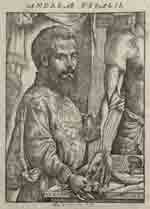Andreas Vesalius
1514-1564
 Andreas Vesalius was a Flemish anatomist who published a highly influential book: On the fabric of the human body, in 1543. His systematic dissections and the drawings in his book revolutionized the conception of various organs of the body and broke tradition with Galenic medicine. He made human dissection a respectable activity, and recommended that all physicians have dissection as part of their training.
Andreas Vesalius was a Flemish anatomist who published a highly influential book: On the fabric of the human body, in 1543. His systematic dissections and the drawings in his book revolutionized the conception of various organs of the body and broke tradition with Galenic medicine. He made human dissection a respectable activity, and recommended that all physicians have dissection as part of their training.
Vesalius on ventricular (did not break with the Galenic view)
... I ventured to ascribe no more to the ventricles than that they are cavities and spaces in which the inhaled air, added to the vital spirit from the heart, is, by power of the peculiar substance of the brain, transformed into animal spirit (Singer, 1925, p. 39).
Andreas Vesalius was born in Brussels, Belgium. He studied medicine in Paris and Italy where he met artists who were studying skeletons and dissecting bodies to make their paintings more realistic. He enlisted the aid of one student, Jan Stephan van Calcar, an apprentice to Titian, to draw his anatomical dissections.
Writings by Vesalius
Vesalius, Andreas (1543, 1545, 2010) On the fabric of the human body http://vesalius.northwestern.edu.gate.lib.buffalo.edu/flash.html. Translated and annotations by D. Garrison & M. Hast. Retrieved on May 4, 2010.
Writings about Vesalius
O’Malley, C. D. Andreas Vesalius of Brussels, 1514-1564. Berkeley: University of California Press.
Saunders, J. B. de C. and O’Malley, C. D. (1950/1973) Vesalius: The illustrations from his works.
Singer, C.J. (1952). Vesalius on the human brain. London, UK: Oxford University Press. (An English translation of the work of Vesalius.)
